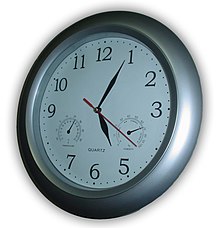นาฬิกา
นาฬิกา เป็นเครื่องมือสำหรับใช้บอกเวลา โดยมากจะมีรอบเวลา 12 ชั่วโมง หรือ 24 ชั่วโมง สำหรับนาฬิกาทั่วไป มีเครื่องหมายบอกชั่วโมง นาที หรือวินาที เครื่องมือสำหรับจับเวลาระยะสั้นๆ เรียกว่านาฬิกาจับเวลา เดิมนั้นเป็นอุปกรณ์เชิงกล มีลานหมุนขับเคลื่อนกำลัง และมีเฟืองเป็นตัวทดความเร็วให้ได้รอบที่ต้องการ และใช้เข็มบอกเวลา โดยใช้หน้าปัดเขียนตัวเลขระบุเวลาเอาไว้ ลักษณนามของนาฬิกา เรียกว่า “เรือน” แต่ก็มีนาฬิกาแบบอื่นๆ ซึ่งใช้บอกอีก เช่น นาฬิกาทราย ใช้จับเวลา, นาฬิกากะลา เป็นกะลาเจาะรูใช้จับเวลา โดยการลอยในน้ำ จนกว่าจะจมก็ถือว่าหมดเวลา, นาฬิกาแดด เป็นการตั้งเครื่องมือเพื่อให้สังเกตการเคลื่อนที่ของดวงอาทิตย์ โดยดูจากเงาของเครื่องมือ บางครั้งเราก็มีการบอกเวลาโดยใช้เครื่องมืออื่น ซึ่งไม่ได้เรียกว่าเป็น นาฬิกา เช่น การตีกลองบอกเวลาเพล ของพระสงฆ์, การตีฆ้องบอกเวลาของแขกยาม หรือการยิงปืนบอกเวลา เป็นต้น

ดูเพิ่ม
แก้อ้างอิง
แก้- Baillie, G.H., O. Clutton, & C.A. Ilbert. Britten’s Old Clocks and Watches and Their Makers (7th ed.). Bonanza Books (1956).
- Bolter, David J. Turing's Man: Western Culture in the Computer Age. The University of North Carolina Press, Chapel Hill, N.C. (1984). ISBN 0-8078-4108-0 pbk. Very good, readable summary of the role of "the clock" in its setting the direction of philosophic movement for the "Western World". Cf. picture on p. 25 showing the verge and foliot. Bolton derived the picture from Macey, p. 20.
- Bruton, Eric. The History of Clocks and Watches. London: Black Cat (1993).
- Dohrn-van Rossum, Gerhard (1996). History of the Hour: Clocks and Modern Temporal Orders. Trans. Thomas Dunlap. Chicago: The University of Chicago Press. ISBN 0226155102.
- Edey, Winthrop. French Clocks. New York: Walker & Co. (1967).
- Kak, Subhash, Ph.D. Babylonian and Indian Astronomy: Early Connections. February 17, 2003.
- Kumar, Narendra "Science in Ancient India" (2004). ISBN 81-261-2056-8.
- Landes, David S. Revolution in Time: Clocks and the Making of the Modern World. Cambridge: Harvard University Press (1983).
- Landes, David S. Clocks & the Wealth of Nations, Daedalus journal, Spring 2003.
- Lloyd, Alan H. “Mechanical Timekeepers”, A History of Technology, Vol. III. Edited by Charles Joseph Singer et al. Oxford: Clarendon Press (1957), pp. 648–675.
- Macey, Samuel L., Clocks and the Cosmos: Time in Western Life and Thought, Archon Books, Hamden, Conn. (1980).
- Needham, Joseph (2000) [1965]. Science & Civilisation in China, Vol. 4, Part 2: Mechanical Engineering. Cambridge: Cambridge University Press. ISBN 0521058031.
- North, John. God's Clockmaker: Richard of Wallingford and the Invention of Time. London: Hambledon and London (2005).
- Palmer, Brooks. The Book of American Clocks, The Macmillan Co. (1979).
- Robinson, Tom. The Longcase Clock. Suffolk, England: Antique Collector’s Club (1981).
- Smith, Alan. The International Dictionary of Clocks. London: Chancellor Press (1996).
- Tardy. French Clocks the World Over. Part I and II. Translated with the assistance of Alexander Ballantyne. Paris: Tardy (1981).
- Yoder, Joella Gerstmeyer. Unrolling Time: Christiaan Huygens and the Mathematization of Nature. New York: Cambridge University Press (1988).
- Zea, Philip, & Robert Cheney. Clock Making in New England – 1725-1825. Old Sturbridge Village (1992).
- ซูม. ตำนานนาฬิกาไทยแลนด์จากมิโด้ถึง "ริชาร์ด มิลด์" หน้า 5. ไทยรัฐปีที่ 69 ฉบับที่ 21926 (วันพฤหัสบดีที่ 1 กุมภาพันธ์ พ.ศ. 2561 แรม 1 ค่ำ เดือน 3 ปีระกา)
แหล่งข้อมูลอื่น
แก้วิกิมีเดียคอมมอนส์มีสื่อเกี่ยวกับ นาฬิกา